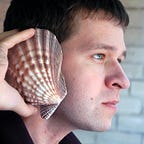The influence of the evolution of perception of reality on the artistic tradition
Any artistic activity is a personalized interpretation of reality. However, this personalization depends not only on the personal experience of the artist, but also, to a large extent, on the way of presenting reality in his mind. It should be noted that during the development of mankind, this way has constantly undergone and is undergoing significant evolution, which is now accelerating exponentially.
At the first stage, the reality was presented exclusively by personal observations and oral statements of witnesses. This led to a significant subjectification of what was seen. In other words, the presentation of reality had no means to calculate its relevance. This led to the emergence of various legends and fictional science. Artistic activity consisted of constructing various myths of the so-called “high mimesis”, the main characters of which were various gods and fantastic creatures. Later, with the development of means of fixing reality, when paper documents and measuring instruments appeared, the amount of fantasy in the perception of reality decreased significantly. At a certain stage, this led to the illusion of a realistic depiction of reality, when the artist seemed to be able to create a completely relevant picture of his surroundings by the means available to him. In fact, although the degree of relevance has increased significantly, it was impossible to create a fully relevant picture. However, this was not the task of the artist. The main artistic task was to make the picture created for different purposes seem relevant and convince the audience of the existence of such a reality, even if nothing like it actually existed. Poor memory, lack or extremely limited individual experience of the audience and local beliefs contributed to the successful solution of this problem. In the third stage, when at the beginning of the twentieth century very developed means of fixing individual experience appeared, there was a significant evolution in the perception of reality, which led to a series of modernist traditions — modernism, postmodernism and metamodernism. The main difference between these traditions and previous experience was that they mastered a very wide range of possibilities for capturing individual experience, which radically changed the practice of presenting reality in a work of art. These opportunities had clearly separated phases of development in the media:
modernism — cinema, radio, telegraph;
postmodernism — television, video;
metamodernism — smartphone, mobile internet, social networks.
The most interesting phase is metamodernist, because it offers such a degree of involvement in someone else’s individual experience and its speed, which was previously even difficult to imagine. This led to the final belief that a relevant image of reality is possible only asymptotically, that is, in a constant approximation of varying degrees. But the very process of approximation leads to an excessive flow of facts. This redundancy is best seen in the artistic practice of the United States, as this country has made the most progress in the evolution of media: primarily the music of Rob Crow, the lyrics of David Foster Wallace and the films of Wes Anderson. However, significant examples of this practice can be seen in other countries. When we talk about metamodernism, its main principle now must be recognized as the excessive flow of facts, which is the best evidence of the surrounding reality.
